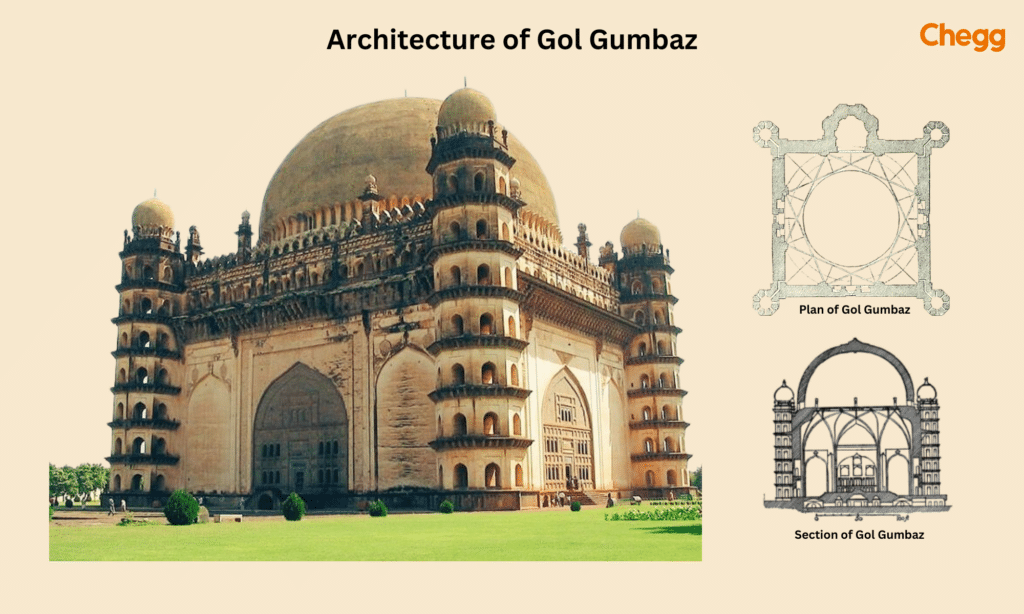
Quick Summary
Table of Contents
Deemed as the Taj Mahal of South India, the Gol Gumbaz in Bijapur, Karnataka state, is a marvel of Indo-Islamic architecture. Its intricate architecture and exquisite construction have made it a popular attraction among history buffs around the world. It is known for its acoustic features and great dimensions. Built in 1656, it took 30 years to complete the construction of the Gol Gumbaz. The mausoleum was designed by Yaqut of Dabul.
The southern region of India sports less Indo-Islamic architecture than the northern region. Gol Gumbaz is one of the few examples. It is also popular because of the distinct southern regional style of architecture not found in the country’s northern parts.
Gol Gumbaz had the largest dome of any Islamic structure in the country for years after its construction. It is also the second largest dome ever built, next in size only to St Peter’s Basilica in Rome. It is an exceptional task for artisans to use bronze to create the mesmerizing structure of the Gol Gumbaz.
The Gol Gumbaz’s history is rich. It is a mausoleum that contains the mortal remains of Mohammad Adil Shah. He was the seventh Sultan of the Adil Shahi dynasty, which was spread over southern India. Later, the dynasty was merged into the Mughal Empire.
Mohammad Adil Shah was 15 when he became the Sultan of the dynasty. At such a young age, he became obsessed with death. He wanted to build a mausoleum for his mortal remains that was greater and bigger than his father’s. He was also scared that he might get buried in a common tomb after his death. Thus, he started building the Gol Gumbaz in the year 1627. The vast dimensions of the place proved to be a daunting task for artisans. Thus, the construction continued till 1656. The incomplete building was converted into the tomb of Adil Shah II.
The mausoleum shares its location with the dargah of Hashim Pir, a Sufi saint. This closeness proves that the Sultan shared a close relationship with the saint.

The mausoleum of Gol Gumbaz is recognized for its massive dome. It is one of the finest examples of Deccan Indo-Islamic architecture. Constructed with dark grey basalt, the dome rises up to 51 meters with an external diameter of 44 meters. You can witness a square podium with a wooden canopy intricately carved inside the museum hall.
The gravestone, placed in the middle of the podium, marks the actual location of the tomb of the Sultan. The hall of the mausoleum is stretched up to an area of 18,000 sq ft, which makes the mausoleum one of the largest single-chamber spaces in the world. It must be known that the dome of the spectacular Gol Gumbaz is not supported by any pillars or towers, thus glorifying the architectural excellence of India
Goal Gumbaz has an interesting feature worth the experience. It houses a whispering gallery right beneath the tomb. This gallery runs around the entire inner periphery of the dome. A semi-darkness aura mostly surrounds the Whispering Gallery is a massive structure in architectural history worldwide. The whispering gallery is renowned for its echoes, even of the faintest voice. Any sound made here is echoed more than 7 times inside the whispering gallery. It is one of the most fantastic acoustic experiences you can relish at the Gol Gumbaz.
The Gol Gumbaz of Bijapur is known for its four iconic minarets. These minarets define the structure and architecture of the rich Indian history of the 17th century. Acting as a vantage point, these minarets are symbols of aesthetic beauty and their role in acting as a support to the world’s largest dome – Gol Gumbaz. The massive structure is adorned by the dome-capped towers on four sides. Each tower rises up to 7 storeys with a staircase built inside it. It also plays a vital role in acting as the acoustic of the massive tower, a whispering gallery. This gallery creates an echo effect that echoes even the faintest voice.

The reign of Muhammad Adil Shah’s history dates back to 1481 A.D., when Mohammad Gawan was executed, and the Bahmani kingdom was divided into 5 independent kingdoms. The Bijapur kingdom was one of them.
Yusuf Adilkhan was the governor of Bijapur at that time. He readily declared his independence and took the ‘Shah’ title. Finally, he founded the AdilShahi dynasty in 1489 A.D. AdilShahis reigned for almost 2 centuries. Bijapur was a prosperous kingdom under the Shah dynasty. It was marked for religious tolerance, artistic excellence, and architectural recognition. One could witness the flourishing art and commerce in the kingdom.
Adhering to its motto, the dynasty made Bijapur a pioneer in the literary field. The Bijapur School of Art speaks about the artistic glory of Bijapur. The most remarkable establishment was made under the reign of the seventh ruler of Bijapur, Ibrahim Adil Shah II.
Adil Shah II is commemorated for his simple yet magnificent mausoleum of Bijapur – Gol Gumbaz. It is the second-largest dome in the world. It’s whispering gallery shines through. Other establishments, such as Ibrahim Rouza and the Jama masjid, signify the artistic eminence of Bijapur under Adil Shah.
There are more fascinating things to know about this monument. We will discuss 10 interesting facts about Gol Gumbaz in the latter part of this page.


Gol Gumbaz, situated in Bijapur, is widely known for its symmetrical architecture and commendable echo system. The echo system is designed so that even the faintest sound can be heard at about 37 meters. The huge edifice is a structure with dark grey basalt. It is one of the amazing structures of the Deccan Indo-Islamic architectural style. It is also known as the Black Taj Mahal.
An interesting fact about the Gol Gumbaz and the Taj Mahal began their establishment at the same time. Gol Gumbaz was established as a mausoleum of Mohammed Adil Shah, whereas Mughal Emperor Shah Jahan established the Taj Mahal. Gol Gumba took at least 29 years to get completed, whereas the Taj Mahal took 22 years to finish. However, Gol Gumbaz is double the size of the Taj Mahal.
The Taj Mahal, on the other hand, is also a remarkable tower in the whole range of Indo-Islamic architectural styles. It has a beautiful combination of solids, concave and convex, light shadow, and voids. The Taj Mahal is one of the best illustrations of the raised tomb variety. The white – ivory – marble work and use of precious and semi-precious stones shine through in the monument.
Also Read:-
Jantar Mantar: A Wonder’s Journey
7 Wonders of India: Architectural Marvels
Safdarjung’s Tomb in Delhi: Entry Fee, Timings, History, and Construction
The tourism industry of Bijapur flourishes due to the presence of the Gol Gumbaz. “If this was the marvel in its incomplete state, what would it have been if it were completed?” – a tourist cited.
Whether you are an architecture enthusiast, this marvellous creation is worth a watch. Bijapur is adorned with transportation facilities. It is a well-connected city with all the major cities of North and South India. Being a tourist, you can also take the help of public transport, such as buses or train,s to reach the place. Once you reach Bijapur, grab an auto or a taxi and arrive at your destination easily and comfortably.
Gol Gumbaz is open on all 7 days of the week. The time ranges from 10 am to 5 pm. You need to pay extra for the camera. Moreover, you can avail of a tourist guide who can share the place’s historical significance.
The tourist attraction has increased in a couple of years to 2000 tourists per day in Bijapur’s Gol Gumbaz. Exploring the architectural and auditory marvels of our history is a must-visit. We have accumulated a few testimonials from people who visitedthe Gol Gumbaz.
When you visit the top, you will be amazed at how good the techniques were in the 17th century – a visitor said about the Gol Gumbaz. If you are in Bijapur, you have to visit this – another visitor said.
These 10 interesting facts about Gol Gumbaz provide a deeper insight into the historical, architectural, and cultural importance of Gol Gumbaz, making it a fascinating subject for history enthusiasts and casual visitors alike.
| Category | Details |
|---|---|
| Timings | 6:00 AM to 6:00 PM |
| Entry Fee | Indian Nationals – Rs. 20/- Foreign Visitors – Rs. 250/- Children up to 15 years – No fees |
| Famous For | Mausoleum, Tomb, Historic Place |
| Visit Duration | 1 to 2 hours |
The imposing Gol Gumbaz tomb rivals even India’s most famous mausoleums. Here are some insider tips to enhance your visit:
Bijapur boasts excellent connectivity, making it easily accessible from various cities in South and West India. Here’s how you can navigate your way:
For a truly unique experience, consider a ride in a horse-drawn trolley, adding a touch of nostalgia to your journey.
Currently, Bijapur awaits the completion of its new airport. In the meantime, the nearest airport is Sambre Airport in Belgaum, situated approximately 164 kilometres away.
Choose your preferred mode of transportation based on your budget and desired experience. With its convenient accessibility, Bijapur welcomes you to explore the architectural marvel of Gol Gumbaz.
Primarily, the Gol Gumbaz was built by Mohammad Adil Shah as his Mausoleum. However, its significant architectural splendour has become a spot of tourist interest today. The jaw-dropping structure of Gol Gumbaz is a symbol of commendable civil engineering. It has now been added to the list of world heritage sites. Moreover, the Archaeological Survey of India has attempted to lift its maintenance. Efforts are made to maintain the architectural heritage of this monument so that it can attract as many tourists as the Taj Mahal. It is indeed a treat for the eyes. You can also spend your day at Gol Gumbaz and take in the elixir of our country’s excellence with pride.
The most well-known monument in Vijayapura is the Gol Gumbaz. The tomb belongs to Mohammed Adil Shah, who ruled from 1627 until 1657. Only St. Peter’s Basilica in Rome is larger than this dome, which is the second largest in history. This monument’s core chamber, where every sound is echoed seven times, is a particular draw.
Gol Gumbaz is also referred to by the intriguing moniker “The Black Taj Mahal” or “The Taj Mahal of South India” in historical texts. The ability of the Gol Gumbaz echo to efficiently reflect even the faintest sound and transmit it over a considerable distance for the person at the end to hear makes it impressive to visitors.
Gol Gumbaz was constructed for Muhammad Adil Shah, whose wife was Jahan Begum. In the seventeenth century, she established a suburb outside the crowded city of Bijapur, which at the time had nine lakh residents.
The remains of Muhammad Adil Shah, the seventh sultan of the Adil Shahi dynasty, and a few of his relatives are buried in the Gol Gumbaz.
Built in 1656, it took 30 years to complete the construction of the Gol Gumbaz.
Gol Gumbaz was constructed by Sultan Muhammad Adil Shah of the Adil Shahi dynasty, with its construction beginning in 1626 and completed in 1656.

Authored by, Amay Mathur | Senior Editor




Amay Mathur is a business news reporter at Chegg.com. He previously worked for PCMag, Business Insider, The Messenger, and ZDNET as a reporter and copyeditor. His areas of coverage encompass tech, business, strategy, finance, and even space. He is a Columbia University graduate.
Editor's Recommendations
Chegg India does not ask for money to offer any opportunity with the company. We request you to be vigilant before sharing your personal and financial information with any third party. Beware of fraudulent activities claiming affiliation with our company and promising monetary rewards or benefits. Chegg India shall not be responsible for any losses resulting from such activities.
Chegg India does not ask for money to offer any opportunity with the company. We request you to be vigilant before sharing your personal and financial information with any third party. Beware of fraudulent activities claiming affiliation with our company and promising monetary rewards or benefits. Chegg India shall not be responsible for any losses resulting from such activities.